Grapevine shoot thinning has become a vital practice for me as a home grape grower. It allows me to carefully remove excess shoots from the canopy, maintain vine balance, manage vigor, and enhance the quality of my grapes. By regulating foliage density, shoot thinning improves airflow and sunlight penetration, resulting in healthier vines and grapes with optimal flavor, color, and sweetness.
Additionally, shoot thinning is crucial in disease prevention by reducing the risk of fungal infections. Creating appropriate spacing between shoots enhances airflow, accelerates drying, and discourages moisture retention, creating an environment less conducive to diseases.
While shoot thinning requires time and effort, its impact on my home vineyard is undeniable. In the following sections, I’ll share the techniques, timing considerations, and best practices I’ve learned as a home grape grower. Together, we’ll explore the transformative effects of shoot thinning, empowering you to enhance the health of your vineyard and enjoy a bountiful harvest of delicious, high-quality grapes.
Before we embark on this exciting journey of grapevine shoot thinning, let me give you a sneak peek into what lies ahead. I’ve compiled a comprehensive table of contents to serve as our roadmap throughout this blog post.
Table of Content
- Introduction
- Understanding Grapevine Shoots
- How Shoot Vigor and Density Can Impact Grapevine Health and Fruit Production
- Reasons For Grapevine Shoot Thinning
- Techniques and Timing of Grapevine Shoot Thinning
- Tools and Equipment For Grapevine Shoot Thinning
- Best Practices For Grapevine Shoot Thinning
- Potential Risks and Limitations of Grapevine Shoot Thinning
- Conclusion
Understanding Grapevine Shoots
As a home grape grower, it’s essential to have a solid understanding of grapevine shoots, the building blocks of your vines. This section delves into the fascinating world of grapevine anatomy and its growth cycle.
Anatomy of a Grapevine Shoot
Grapevine shoots play a crucial role in the growth and development of grapevines, and understanding their anatomy is essential for effective shoot thinning. Let’s explore the key components of a grapevine shoot in simple terms:
Main Stem
The main stem, also known as the cane, is the primary structural element of a grapevine shoot. It serves as the backbone from which other parts of the shoot emerge.
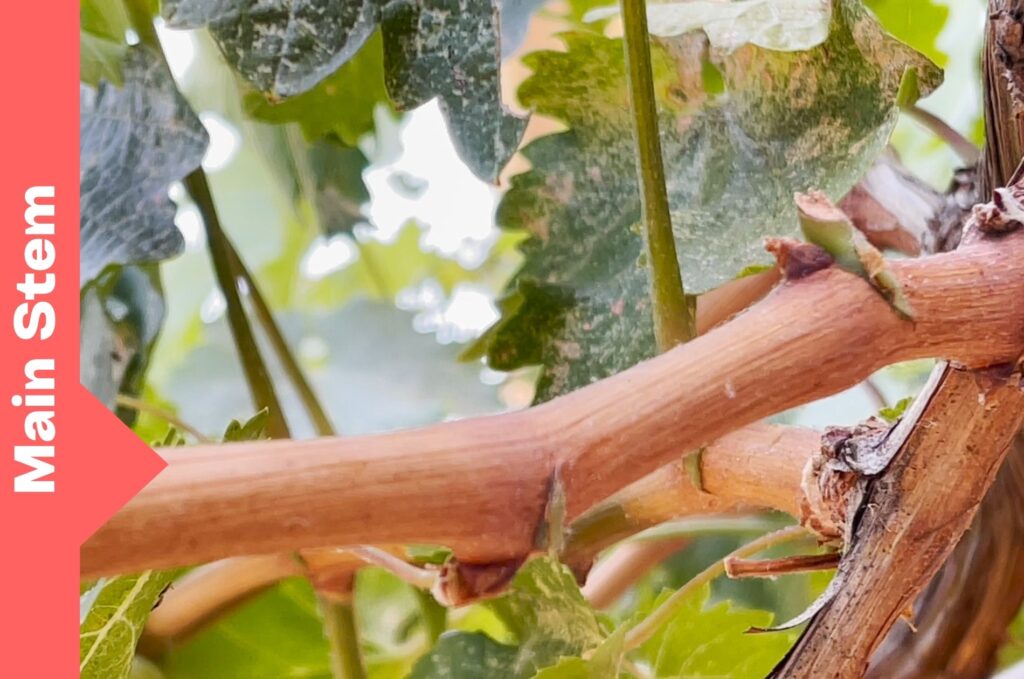
Nodes
Nodes are the points along the main stem where leaves, tendrils, and inflorescences (flower clusters) are attached. Each node represents a potential growth point for shoots and fruiting.

Internodes
Internodes are the segments of the main stem between adjacent nodes. They determine the spacing between leaves and influence the overall length of the shoot.
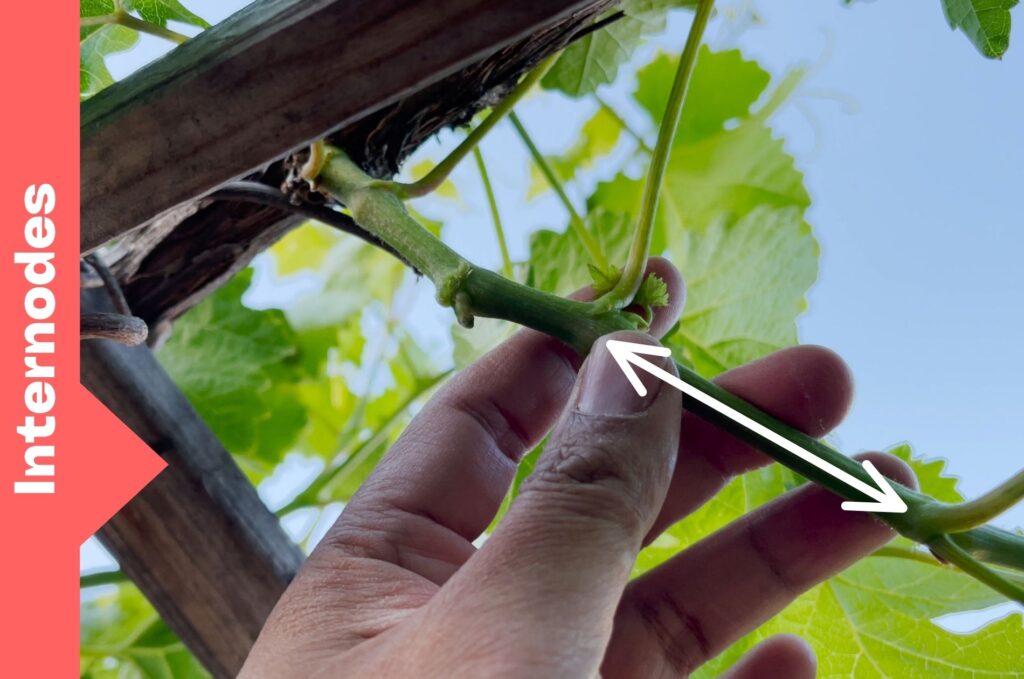
Leaves
Leaves are essential for photosynthesis, the process by which plants convert sunlight into energy. They provide shade, protect the grape clusters, and contribute to the vine’s health.
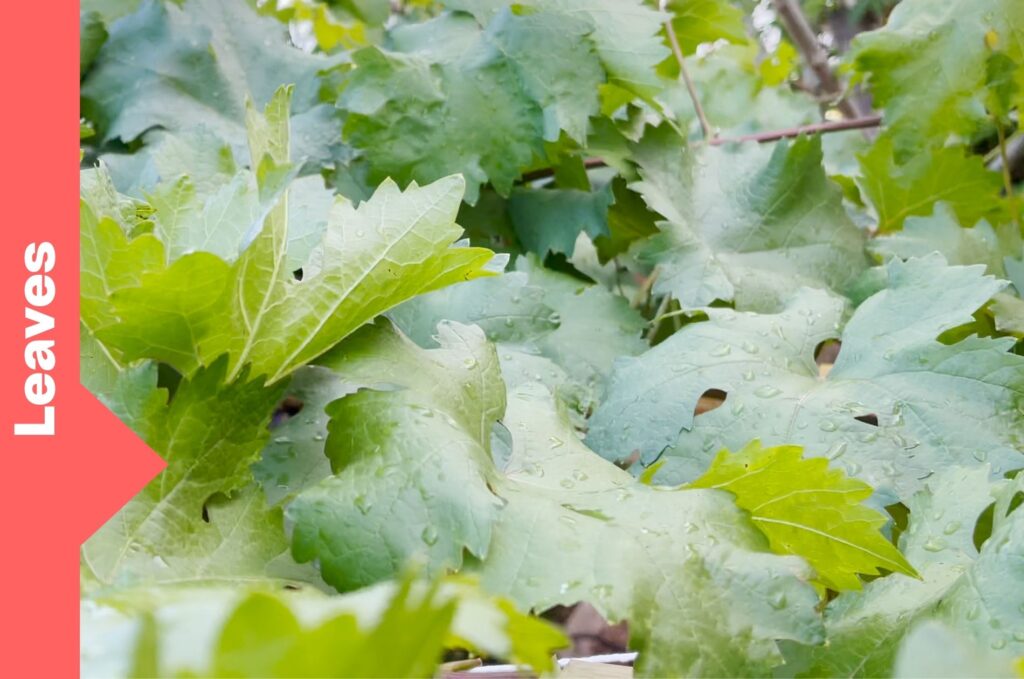
Tendrils
Tendrils are thin, coiled structures that emerge from nodes. They aid in anchoring the grapevine to support structures and assist in climbing.
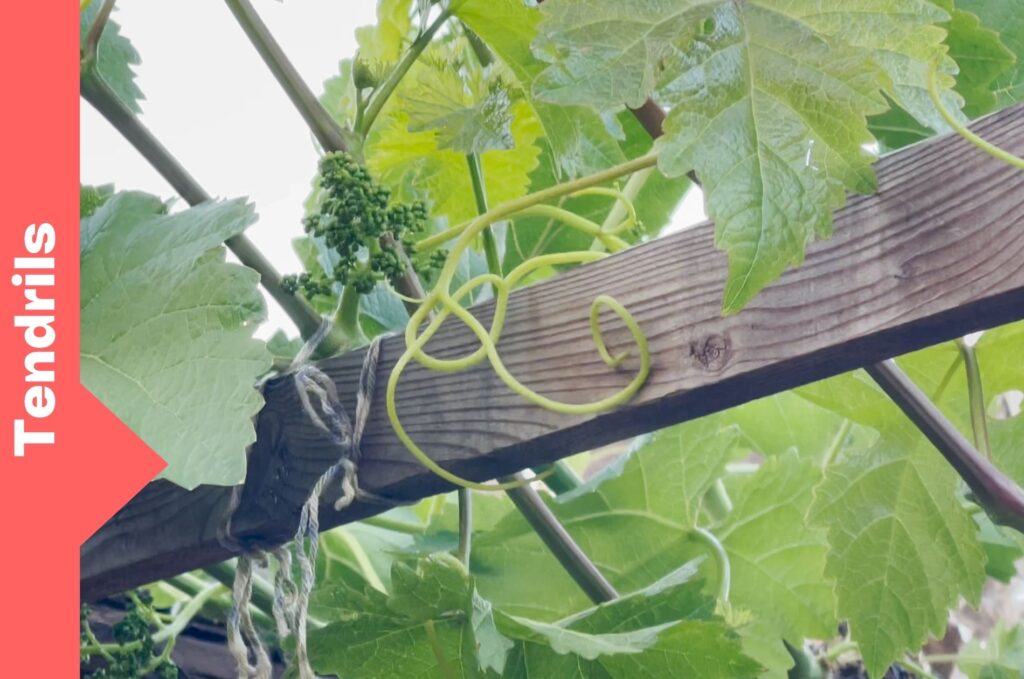
Inflorescences
Inflorescences, or flower clusters, emerge from certain nodes and eventually develop into grape clusters. They are the precursors to the delicious fruits we aim to cultivate.

The Growth Cycle of Grapevines and Its Implications for Shoot Development
Understanding the growth cycle of grapevines is fundamental to grasping how shoot development unfolds in a home vineyard. The growth cycle can be divided into key stages, each with unique implications for shoot growth and management. Let’s explore these stages and their significance:
Dormancy
The growth cycle begins during winter when grapevines enter a period of dormancy. During this phase, the vine rests, and its energy is stored in the trunk and roots. Shoot growth is minimal or nonexistent at this stage, making it an ideal time for pruning and preparing the vine for the upcoming growing season.
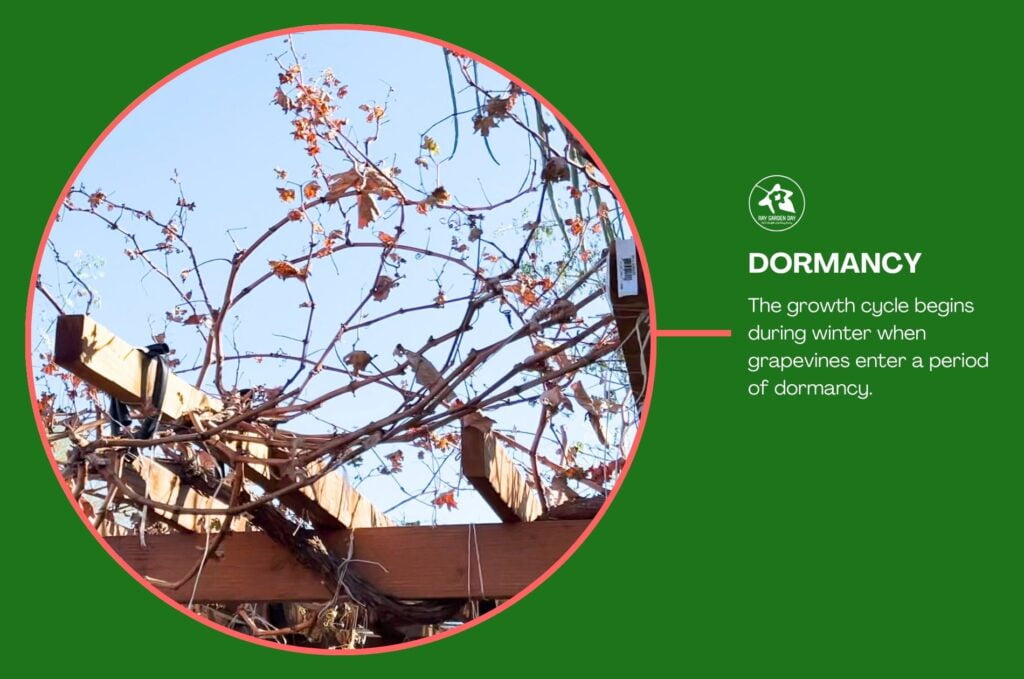
Bud Break
As temperatures rise and the weather becomes more favorable in early spring, the dormant buds on the grapevine begin to swell and eventually burst open. This stage is known as bud break. New shoots emerge from these buds and start elongating rapidly. It is crucial to monitor bud break closely, as late spring frost events can be detrimental to the young, tender shoots.
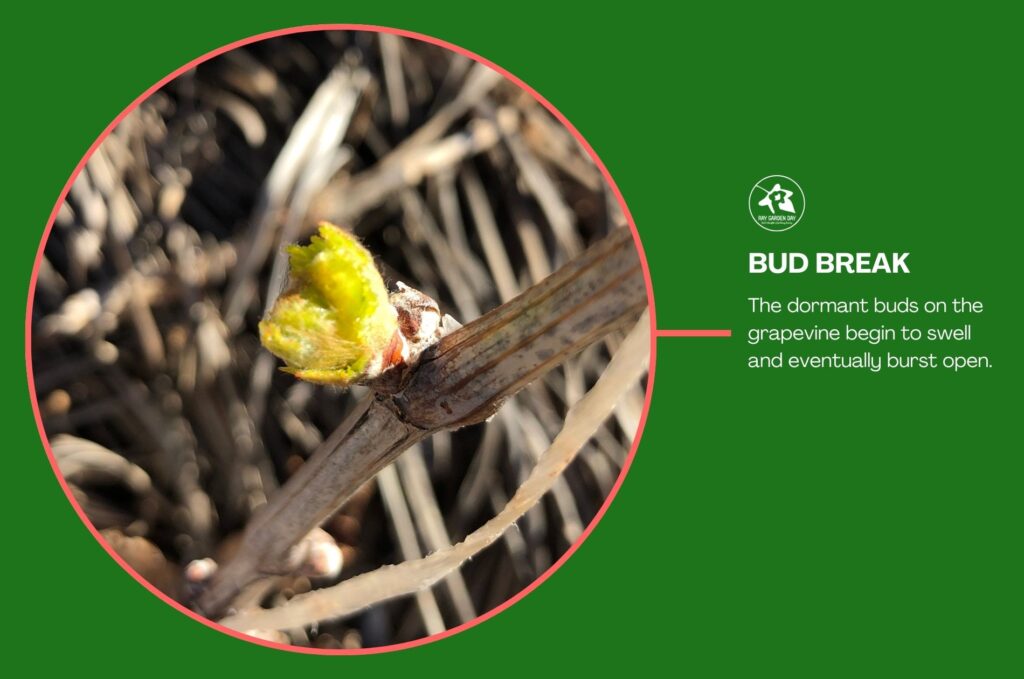
Shoot Growth
Following bud break, the shoots enter a period of rapid growth. They elongate and produce leaves, tendrils, and inflorescences. Shoot thinning becomes essential during this phase to maintain proper vine balance and manage vigor. By selectively removing excess shoots, we ensure an optimal distribution of resources and prevent overcrowding.
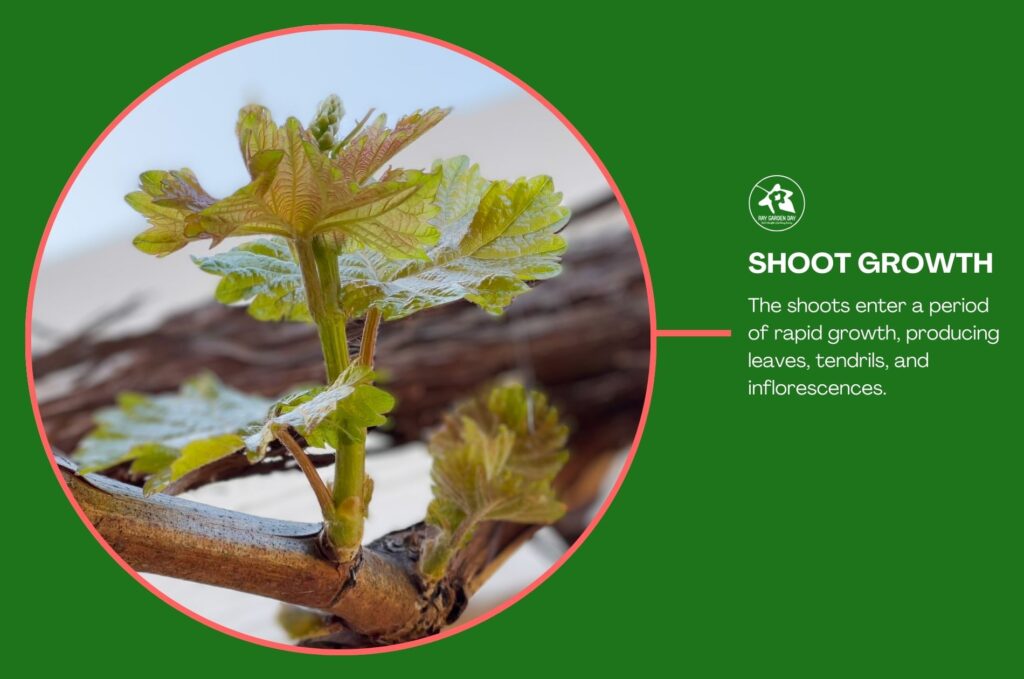
Flowering and Fruit Set
The shoots transition from vegetative growth to reproductive growth during this stage. Inflorescences develop into flowers, and successful pollination leads to fruit set, where the flowers transform into tiny grape clusters. Adequate shoot thinning at this point is crucial to promote airflow, sunlight penetration, and proper fruit development.

Veraison
Veraison marks the onset of ripening. The grapes undergo color changes, softening, and increased sugar content. Shoot thinning is typically complete by this stage, focusing instead on canopy management and optimizing sunlight exposure to the grape clusters.
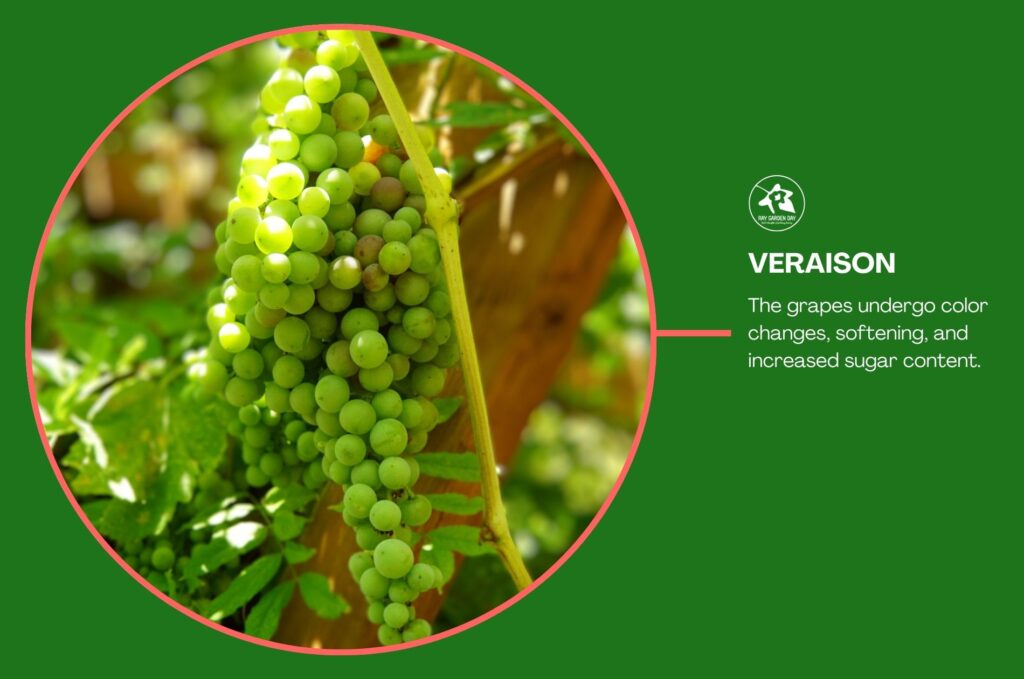
Harvest
The final growth cycle stage is harvest, where the grapes reach their optimal ripeness. It is the culmination of the year’s efforts and the most anticipated moment for home grape growers. By practicing proper shoot thinning throughout the growth cycle, we contribute to developing high-quality grapes with desirable characteristics.
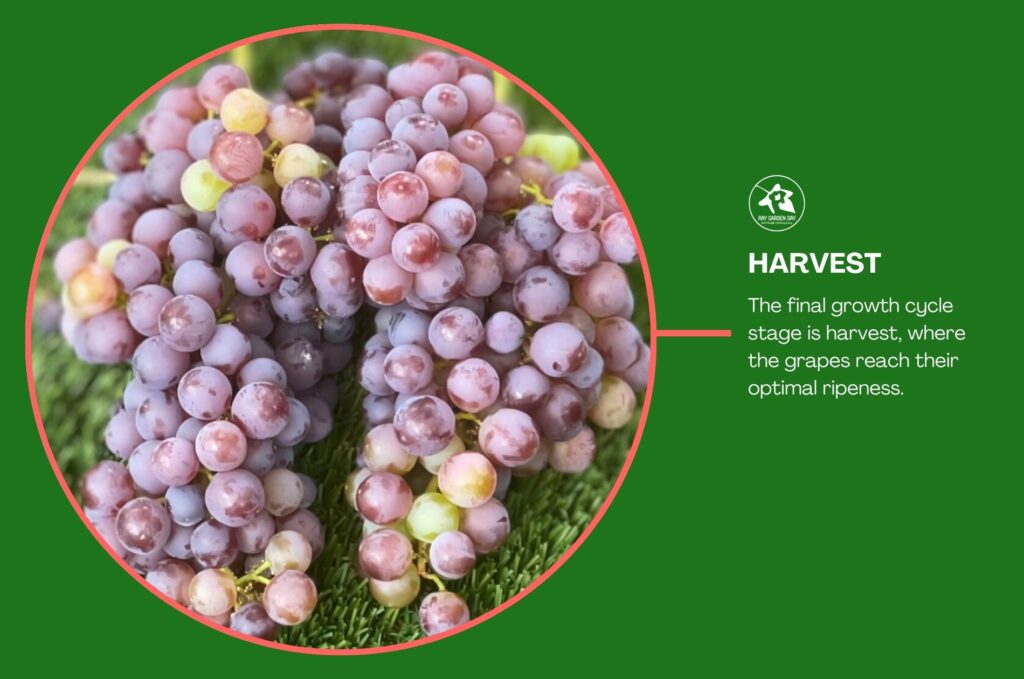
Understanding the growth cycle of grapevines allows us to anticipate the stages of shoot development and make informed decisions regarding shoot thinning and overall vineyard management. By aligning our practices with the growth cycle, we can nurture healthy shoots, maximize grape quality, and achieve a successful harvest in our home vineyards.
Throughout the growth cycle, it is essential to adapt shoot thinning techniques based on the specific requirements of grape varieties, local climate conditions, and the desired balance of vine vigor. In the following sections, we will explore these considerations, providing guidance on timing, techniques, and best practices for effective shoot thinning in a home vineyard setting.
Download The Growth Cycle of Grapevines and Its Implications for Shoot Development Infographic [PDF 3.8 MB]
Grapevine Shoots FAQs
When should I start shoot thinning in my home vineyard?
Begin shoot thinning when the shoots have reached approximately 5-10 inches long to ensure proper vine balance and avoid excessive vegetative growth.
How does shoot thinning affect grape quality?
Shoot thinning improves grape quality by enhancing airflow, sunlight penetration, and spray coverage, resulting in healthier vines, reduced disease risk, and optimal flavor, color, and sugar content.
Should I continue shoot thinning after fruit set?
No, it’s best to complete shoot thinning before or during fruit set. Once fruit set occurs, focus on canopy management and optimizing sunlight exposure for the developing grape clusters.
How Shoot Vigor and Density Can Impact Grapevine Health and Fruit Production
Shoot vigor and density are critical in determining grapevines’ overall health and ability to produce quality fruit. Understanding the impact of these factors is vital for effective shoot thinning and vineyard management. In the following sections, we’ll explore how shoot vigor and density can influence grapevine health and fruit production.
Shoot Vigor
Shoot vigor refers to the growth strength and vitality of grapevine shoots. Vigorous shoots tend to grow rapidly, produce excessive foliage, and may have an imbalance in fruit-to-vegetative growth. On the other hand, weak or low-vigor shoots may exhibit stunted growth and insufficient foliage development.
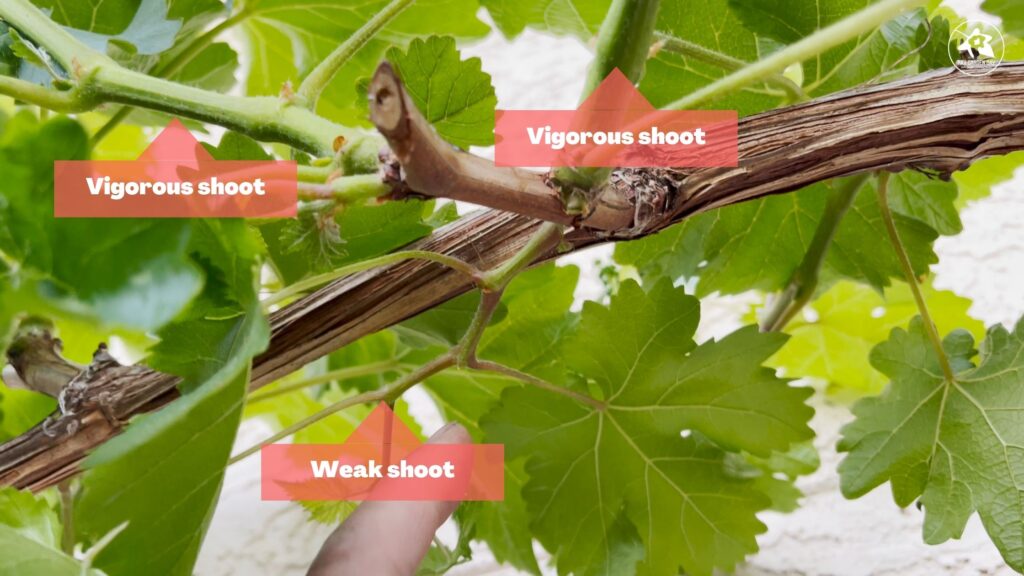
Excessive shoot vigor can have negative consequences on grapevine health and fruit production. Dense foliage resulting from vigorous shoots restricts airflow, leading to poor ventilation within the canopy. This can create a favorable environment for the development of fungal diseases, such as powdery mildew and downy mildew. Moreover, dense foliage blocks sunlight penetration, limiting the exposure of grape clusters to sunlight, which is crucial for proper ripening and flavor development.
Conversely, shoots with low vigor may struggle to support healthy fruit development. Insufficient leaf area from weak shoots may compromise the vine’s ability to produce and accumulate sugars through photosynthesis, leading to underripe or low-quality grapes. Therefore, balancing shoot vigor through appropriate shoot thinning practices is essential, allowing optimal fruit development, disease prevention, and overall vine health.
Shoot Density
Shoot density refers to the number of shoots per vine or unit area within the vineyard. Shoot density affects the distribution of resources, such as water, nutrients, and sunlight, among the shoots. High shoot density can result in resource competition, decreased fruit quality, and increased disease susceptibility.
When shoots are densely packed, the lack of airflow and reduced sunlight penetration promote a humid microclimate within the canopy. This creates an environment conducive to the development and spread of fungal diseases. Additionally, closely spaced shoots make applying pesticides or conducting proper spray coverage challenging, compromising disease management efforts.
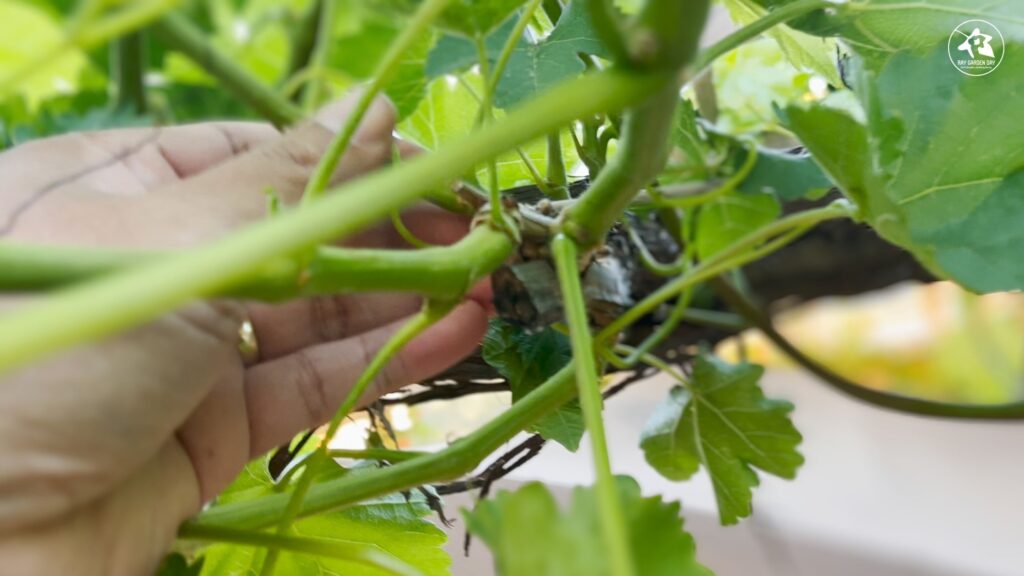
We can optimize resource allocation, improve airflow, and enhance sunlight exposure within the vineyard by implementing shoot thinning to reduce shoot density. This helps mitigate disease pressure, minimize the risk of grape rot, and promote healthy fruit development.
Maintaining an appropriate balance of shoot vigor and density through effective shoot thinning practices is crucial for maximizing grapevine health, ensuring high-quality fruit production, and achieving a successful home vineyard harvest.
We will explore practical techniques and guidelines for proper shoot thinning in the upcoming sections.
Shoot Vigor and Density FAQs
How can I determine if my grapevine shoots have excessive vigor?
Look for rapid growth, excessive foliage, imbalanced fruit-to-vegetative growth, and a dense canopy. These signs indicate high shoot vigor that may require thinning.
What are the consequences of high shoot density in my vineyard?
High shoot density leads to poor airflow, limited sunlight penetration, increased disease risk, and compromised spray coverage, negatively impacting grape quality and overall vine health.
How does shoot thinning help manage shoot density and vigor?
Shoot thinning reduces shoot density, allowing better resource allocation and airflow. It also helps balance shoot vigor, promoting healthier vines, disease prevention, and optimal fruit development.
Reasons For Grapevine Shoot Thinning
Shoot thinning is a vital practice in home grape growing, offering numerous benefits for the health and productivity of your grapevines. Here are some key reasons why shoot thinning is essential:
- Enhanced Vine Balance: By selectively removing excess shoots, shoot thinning helps balance vegetative growth and fruit production. This balance optimizes resource allocation and promotes healthier, more productive vines.
- Improved Airflow: Dense foliage can impede airflow within the grapevine canopy, creating a humid environment that favors disease development. Shoot thinning opens the canopy, facilitating better airflow and reducing the risk of fungal infections.
- Optimal Sunlight Penetration: Sunlight is crucial for photosynthesis, grape ripening, and flavor development. Thinning the shoots allows for better sunlight penetration into the canopy, ensuring optimal exposure for grape clusters and improving their quality.
- Disease Prevention: Dense foliage from unthinned shoots provides an ideal environment for fungal diseases. By thinning the shoots, you reduce foliage density, enhance drying, and discourage disease proliferation.
- Improved Spray Coverage: Effective pest and disease control relies on proper spray coverage. Thinning the shoots improves access to all parts of the vine, facilitating better spray penetration and coverage, leading to more effective protection.
- Quality Grape Production: Shoot thinning helps achieve high-quality grapes with desirable attributes, such as optimal sugar content, flavor concentration, color development, and balanced acidity. Thinning promotes the conditions necessary for grapes of exceptional taste and visual appeal.
By understanding these reasons and implementing proper shoot thinning techniques, you can optimize your home vineyard’s health, productivity, and overall quality, ultimately enjoying a bountiful harvest of delicious grapes.
Reasons for Grapevine Shoot Thinning FAQs
Why is vine balance important, and how does shoot thinning contribute to it?
Vine balance ensures an optimal distribution of resources between vegetative growth and fruit production. Shoot thinning helps maintain this balance by selectively removing excess shoots, promoting healthier, more productive vines.
Can shoot thinning really prevent diseases in my vineyard?
Yes, shoot thinning plays a crucial role in disease prevention. By reducing foliage density and improving airflow within the canopy, shoot thinning creates an environment less favorable for fungal diseases to thrive.
How does shoot thinning impact the quality of grapes produced?
Shoot thinning positively influences grape quality in multiple ways. It improves sunlight penetration, improving ripening, flavor development, and color. Thinning also allows for more efficient pest and disease control, enhancing grape quality.
Techniques and Timing of Grapevine Shoot Thinning
Grapevine shoot thinning involves employing practical methods and considering the appropriate timing to achieve optimal results in a home vineyard. Let’s explore the fundamental techniques:
Practical Methods of Shoot Thinning For Home Grape Growers
- Manual Techniques: Manual shoot thinning methods are well-suited for home grape growers. These techniques involve selectively removing unwanted shoots by hand or using handheld tools like pruners or scissors. You can make precise thinning decisions by visually inspecting each shoot and considering the vine’s vigor and desired fruit load.
- Selective Shoot Removal: Focus on removing shoots that are excessive, weak, competing for space, or growing in undesirable locations within the canopy. Prioritize thinning shoots that are shaded, crowded, or located near the vine’s base, as they are more likely to contribute to imbalances or disease susceptibility.
- Cluster Thinning: Besides shoot thinning, selectively thinning grape clusters can help manage yield and enhance fruit quality. Remove smaller or unripe clusters to channel the vine’s resources toward fewer, well-developed clusters, resulting in improved fruit characteristics.
Check out my dedicated blog post on Cluster Thinning/Grape Berry Thinning: When and How, the perfect companion to grapevine shoot thinning.

Timing Considerations for Shoot Thinning in a Home Vineyard
- Early Season: Begin shoot thinning when shoots have reached a length of around 5-10 inches. At this stage, shoot growth is sufficiently developed, making it easier to identify and select which shoots to thin.
- Pre-Flowering: Perform shoot thinning before or during the flowering stage. This timing allows for better nutrient allocation to developing flower clusters and reduces the risk of interfering with pollination.
- Fruit Set: Complete shoot thinning before fruit set occurs. Once the grapes start to form, avoid removing shoots or clusters, as this can impact fruit development and yield.
Guidelines for Determining Appropriate Shoot Density and Thinning Intensity
- Shoot Density: Aim for a suitable shoot density for good airflow, sunlight penetration, and optimal resource allocation. The specific shoot density may vary depending on the grape variety, vine vigor, and trellis system. Generally, a balanced shoot density ranges between 4 to 8 shoots per linear foot of vine.
- Thinning Intensity: The intensity of shoot thinning depends on the vine’s vigor, desired yield, and fruit quality goals. Thinning should aim to balance vegetative growth and fruit production appropriately. Consider removing excess shoots, especially in areas with higher shoot density, while leaving sufficient shoots to support the desired fruit load.
Home grape growers can effectively manage vine balance, optimize fruit quality, and promote their grapevines’ overall health and productivity by understanding practical methods, timing considerations, and guidelines for shoot thinning.
Techniques and Timing FAQs
How do I determine which shoots to thin and which to keep during the thinning process?
When deciding which shoots to thin, consider factors such as shoot vigor, position within the canopy, spacing between shoots, and overall vine balance. Remove weaker or excessive shoots, favoring those with better positioning, adequate sunlight exposure, and optimal airflow and disease prevention spacing.
Can I perform shoot thinning after the flowering stage, or is it too late?
It is generally recommended to perform shoot thinning before or during the flowering stage. Thinning after flowering may disrupt fruit set and impact yield. However, suppose some shoots need urgent removal. In that case, selective thinning can still be done, taking care not to disturb the developing clusters.
How frequently should I thin grapevine shoots throughout the growing season?
Shoot thinning is typically performed once during the growing season, usually before or during flowering. However, a second thinning pass may be necessary for vigorous vineyards or with specific grape varieties to ensure the desired shoot density and promote optimal fruit quality. Monitor shoot growth and adjust thinning accordingly.
Tools and Equipment For Grapevine Shoot Thinning
Effective grapevine shoot thinning requires the use of appropriate tools and equipment. Whether you have a small home vineyard or limited resources, selecting the right tools and exploring cost-effective options can ensure efficient and successful shoot thinning.
Basic Tools for Manual Shoot Thinning
For manual shoot thinning, the following essential tools are commonly used:
- Hand Pruners: These are essential for removing unwanted shoots. Look for pruners with sharp blades and comfortable handles for ease of use.
- Pruning Shears or Scissors: Pruning shears or scissors can be helpful for precise and delicate thinning, especially when dealing with smaller shoots or clusters in tight spaces.
- Loppers: Loppers help remove thicker or hard-to-reach shoots. Opt for loppers with long handles for increased leverage and cutting power.
Selecting the Right Tools
When choosing tools for shoot thinning, consider the following factors:
- Quality: Invest in good-quality tools that are durable, as they will last longer and provide more efficient cutting.
- Ergonomics: Choose tools with comfortable handles and a design that fits well in your hand to minimize strain and fatigue during extended use.
- Cutting Capacity: Ensure that the tools you choose can handle the size and thickness of the shoots in your vineyard. Different grape varieties may have varying shoot thicknesses, so consider this when selecting.
- Ease of Maintenance: Opt for easy-to-clean and maintain tools to prolong their lifespan and ensure optimal performance.
Cost-Effective Options and Alternatives
If you have limited resources or a small vineyard, there are cost-effective options and alternatives available:
- Multi-Purpose Tools: Look for multi-purpose tools that can serve multiple functions, such as combining pruning shears and loppers in one tool. These versatile tools can save both space and costs.
- Handheld Pruning Saws: Handheld pruning saws can be a more affordable alternative to loppers for cutting thicker shoots. They are compact, easy to use, and offer good cutting capacity.
- DIY Options: Sometimes, you can repurpose or adapt existing tools to shoot thinning. For example, small kitchen scissors or garden snips can be used for selective shoot removal.
- Bare Hands: Thinning grapevine shoots using bare hands can be effective for small-scale home grape growers. This method requires careful manual selection and removal of excess shoots by gently snapping them off with your fingers. However, ensuring your hands are clean and free from contaminants is essential to prevent potential damage or disease spread.
Remember to prioritize safety while working with tools, wear appropriate protective gear, and follow proper pruning techniques to minimize the risk of injury and ensure effective shoot thinning.
By understanding the essential tools needed, selecting the right tools for your vineyard, and exploring cost-effective options, you can equip yourself with the tools required to effectively carry out grapevine shoot thinning in your home vineyard.
Tools and Equipment FAQs
What type of hand pruners or shears are best suited for grapevine shoot thinning?
Look for bypass pruners with sharp blades and a comfortable grip. Bypass pruners make clean cuts and minimize damage to the remaining shoots. Opt for pruners with a smaller size for better maneuverability within the vine canopy.
Can I use electric or battery-powered pruning tools for grapevine shoot thinning?
Electric or battery-powered pruning tools can be used for shoot thinning, especially if you have a large vineyard or physical limitations. However, ensure that the tool is designed for precision cutting and has appropriate blade attachments suitable for grapevine shoots.
Are there any specialized tools available specifically for grapevine shoot thinning?
While specialized tools are available for commercial vineyards, basic hand pruners, pruning shears, and loppers are generally sufficient for home grape growers. These tools are versatile, widely available, and cost-effective for shoot thinning in a smaller-scale setting.
Best Practices For Grapevine Shoot Thinning
To achieve successful grapevine shoot thinning in your home vineyard, following best practices that ensure effective thinning while maintaining vine health is essential.
Step-by-Step Instructions for Manual Shoot Thinning
- Assess Vine Vigor: Evaluate the overall health and vigor of your grapevines. Identify shoots that are excessively vigorous or weak, and prioritize their removal.
- Select Targeted Shoots: Carefully examine each shoot, considering factors like positioning, spacing, and vigor. Choose shoots that are well-positioned, adequately spaced, and have good vigor for retaining.
- Remove Excess Shoots: Use hand pruners or shears to selectively remove unwanted shoots. Cut the shoots close to their base without damaging nearby shoots or clusters.
- Thin Cluster Zones: Pay attention to the cluster zones and thin any excessive shoots or crowded clusters that may impede air circulation and promote disease development.
Tips and Tricks for Proper Vineyard Hygiene and Damage Prevention
- Maintain Clean Tools: Keep your pruning tools clean and sanitized to prevent the spread of diseases. Wipe the blades with a disinfectant between each vine to minimize cross-contamination.
- Minimize Vine Stress: Avoid excessive thinning that can stress the vines. Remove shoots strategically, ensuring an optimal balance between vegetative growth and fruit production.
- Handle Shoots with Care: Be gentle when removing shoots to minimize damage to the remaining shoots, clusters, or buds. Avoid excessive bending or twisting that could cause injuries to the vine.
Common Challenges Faced by Home Grape Growers
- Overcrowded Canopy: Consider implementing more aggressive thinning strategies if your vineyard has an overcrowded canopy. Remove additional shoots to improve airflow and sunlight penetration.
- Uneven Shoot Growth: If you observe significant differences in shoot growth within the vine, adjust thinning intensity accordingly. Prioritize thinning on excessively dominant shoots while leaving some shoots to balance the vine.
- Disease Susceptibility: Monitor the vineyard for signs of disease and address them promptly. Proper thinning practices, such as adequate spacing between shoots, can help minimize disease susceptibility.
Saving a Shoot on a Spur for Future Growth
Sometimes, you may come across a shoot on a spur closer to the cordon, showing potential for future growth. Instead of completely removing it, you can strategically save this shoot for future vine training and renewal. Here’s how:
- Assess Shoot Vigor: Evaluate the vigor and health of the shoot in question. Look for signs of good growth potential, such as healthy foliage, balanced internode spacing, and good bud development.
- Select the Promising Shoot: Choose the most promising shoot based on its vigor, position, and alignment with the desired vine architecture. Select a shoot that is well-positioned and aligned with the training system, ensuring it can contribute positively to the future structure of the vine.
- Protect and Train the Shoot: Carefully protect the selected shoot during thinning. Avoid damaging or breaking it while removing surrounding excess shoots. Provide proper support and training as the vine grows, directing it along the desired path for future vine structure development.
- Monitor and Adjust: Keep a close eye on the saved shoot’s growth throughout the season. Make any necessary adjustments to training or support as the vine develops. Ensure the saved shoot receives proper care, including irrigation, fertilization, and protection from pests and diseases.
By following these best practices, you can ensure effective shoot thinning, maintain vineyard hygiene, minimize vine stress, and address common challenges encountered during the process. Implementing these practices will contribute to your home grape-growing endeavor’s health, productivity, and overall success.
Shoot Thinning Best Practices FAQs
How can I ensure proper vineyard hygiene during shoot thinning to prevent disease spread?
To maintain vineyard hygiene, regularly sanitize your pruning tools with disinfectant wipes or a solution of bleach and water. Clean tools between each vine to avoid cross-contamination and reduce the risk of disease transmission.
What are some tips for minimizing vine stress while performing shoot thinning?
Avoid excessive thinning that removes too many shoots to minimize vine stress. Strive for a balanced approach, removing weaker or excess shoots while leaving enough to support fruit production. Maintaining vine balance helps minimize stress and promote vine health.
How can I prevent damage to the remaining shoots, clusters, or buds during thinning?
Handle shoots with care to prevent damage. Use sharp pruning tools to make clean cuts close to the base of the shoot being removed. Avoid excessive bending or twisting of shoots to prevent injuries to nearby shoots, clusters, or buds.
What should I do if I encounter uneven shoot growth within my vineyard during shoot thinning?
If you notice significant differences in shoot growth within your vineyard, adjust your thinning strategy accordingly. Prioritize thinning on excessively dominant shoots while leaving some shoots to balance the vine. Tailor your thinning intensity to address the specific needs of each vine.
Potential Risks and Limitations of Grapevine Shoot Thinning
While grapevine shoot thinning offers numerous benefits, knowing this practice’s potential risks and limitations is essential. By understanding these factors, you can make informed decisions and optimize the thinning process in your home vineyard.
Risks of Excessive Shoot Thinning and Emphasizing Moderation
- Fruit Sunburn: Excessive thinning can expose grape clusters to direct sunlight, increasing the risk of sunburn. Moderate thinning allows for a balance between fruit exposure and protection, reducing the likelihood of sun damage.
- Reduced Yield: Overzealous thinning can lead to reduced grape yield, as excessive shoot removal limits the potential for fruit production. Practicing moderation ensures a reasonable balance between vegetative growth and fruit development.
- Vine Stress: Removing too many shoots can stress the vine, affecting its overall health and vigor. Moderation in thinning helps maintain vine balance and minimizes stress, promoting better long-term vine performance.
Instead of thinning all at once, I prefer to thin multiple times during the growing season, allowing clusters to form and develop before making further adjustments. This approach helps me assess the vine's overall capacity and determine how much to thin without risking a significant reduction in yield. I can ensure a fruitful harvest while maintaining vine health by patiently observing and adjusting as the season progresses.

Limitations of Shoot Thinning Techniques in a Home Vineyard Context
- Limited Labor and Time: Home grape growers may face limitations in terms of available labor and time. Manual shoot thinning can be labor-intensive, especially for larger vineyards. Consider alternative approaches like selective pruning or cluster thinning to achieve desired results with fewer resources.
- Lack of Specialized Equipment: Home vineyards may need access to specialized thinning equipment used in commercial settings. In that case, focus on manual techniques and tool selection suitable for your vineyard size and needs.
I've discovered that you sometimes need your hands, hand sanitizer, and a pair of pruners to do the job. I've found that simplicity can be effective. By carefully using my hands and pruners, I can manually thin the shoots, ensuring precision and minimizing any potential damage to the vine. Just remember to sanitize your hands and tools regularly to maintain vineyard hygiene.

Monitoring Vine Response and Adjusting Thinning Practices
- Vineyard Variability: Every vineyard has unique conditions and vine responses. Monitor the response of your vines to thinning and adjust your practices accordingly. Observe shoot regrowth, cluster development, and overall vine health to make informed decisions in subsequent seasons.
- Adjusting Thin Density: Fine-tuning shoot density may be necessary based on vineyard-specific factors. Factors like vine vigor, varietal characteristics, and weather conditions may require changing the thinning intensity to achieve optimal vine balance and fruit quality.
By understanding the potential risks and limitations, you can approach grapevine shoot thinning cautiously and adapt your practices to suit your home vineyard conditions. This will help you achieve the desired outcomes while minimizing potential drawbacks.
Risks of Grapevine Shoot Thinning FAQs
What are the risks of thinning grapevine shoots too aggressively?
Overzealous thinning can result in reduced grape yield, as excessive shoot removal limits the potential for fruit production. It’s important to practice moderation to balance vegetative growth and fruit development.
How can excessive shoot thinning lead to sunburn and other fruit-related issues?
When too many shoots are removed, grape clusters become more exposed to direct sunlight, increasing the risk of sunburn.
What are the potential negative effects of vine stress caused by excessive thinning?
Removing an excessive number of shoots can stress the vine, leading to reduced overall vine health and vigor.
Conclusion
In conclusion, grapevine shoot thinning is vital for home grape growers looking to optimize vineyard health and enhance grape production.
Summarizing Key Takeaways:
- Vine Balance: Shoot thinning helps maintain vine balance by regulating shoot density and vigor, ensuring optimal resource allocation for both vegetative growth and fruit development.
- Fruit Quality: Thinning promotes better airflow and light penetration, reducing disease susceptibility and enhancing grape quality attributes such as color, flavor, and sugar accumulation.
- Vineyard Efficiency: Removing excess shoots eliminates overcrowding, allowing for better access during pruning, spraying, and overall vineyard management.
- Increased Fruit Yield: By maintaining an appropriate shoot density, you can maximize grape yield potential and achieve a bountiful harvest.
- Enhanced Disease Management: Thinning reduces disease pressure by improving air circulation and creating an environment less favorable for fungal infections.
- Consistent Fruit Ripening: Thinning promotes even ripening of grapes, ensuring a more uniform harvest and facilitating optimal flavor development.
Armed with the knowledge gained from this guide, I encourage you to apply the principles of grapevine shoot thinning in your own vineyard. Embrace the opportunity to enhance your grape production, savor the joy of growing high-quality homegrown grapes, and share the fruits of your labor with family and friends.
Remember, the journey of mastering grapevine shoots thinning is an ongoing process. Observe and adapt your techniques based on vineyard conditions, varietal characteristics, and personal experience. As you refine your skills, your vineyard will thrive, and the rewards will be evident in each delicious bunch of grapes you harvest.
Happy shoot thinning and happy grape growing!
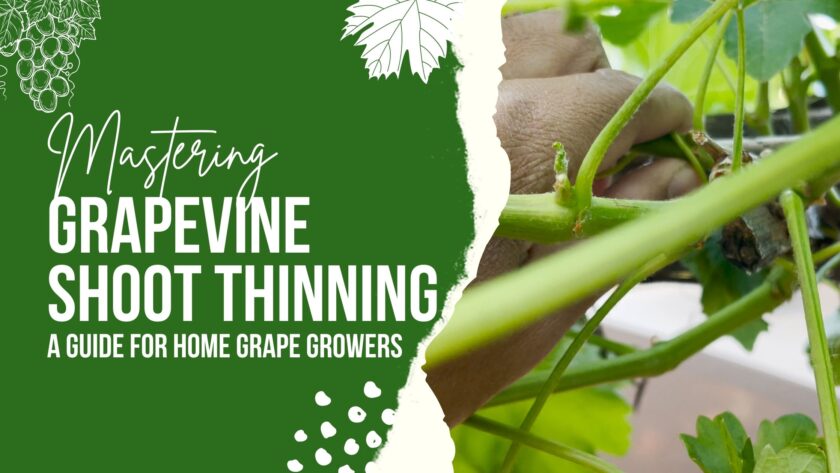

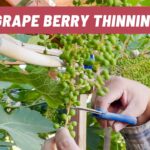
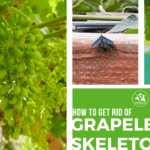
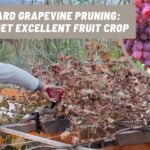
Hi Ray. I’m in Australia and new to backyard grapevine growing, and I cannot thank you enough for all the info I have gleaned from your blog! Yours is by far the most comprehensive and easily understood set of instructions and guidelines on the web, and I am so happy that I stumbled across your blog. Thank you! Thank you! Thank you! Happy gardening. : -)
Hi Heather,
Thank you so much for your incredibly kind words! I’m absolutely thrilled to hear that you found my blog helpful. It’s fellow enthusiasts like you who inspire me to keep sharing and creating content. Here’s to successful grapevine growing and bountiful harvests!
Happy gardening and best wishes from across the globe! 🙂